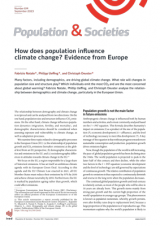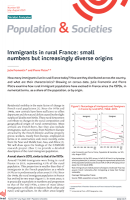
How does population influence climate change? Evidence from Europe
Population and Societies
n° 614, September 2023
https://doi.org/10.3917/popsoc.614.0001
European Commission, Joint Research Centre (JRC)
European Commission, Joint Research Centre (JRC)
European Commission, Joint Research Centre (JRC)
This article explores how population and climate change are related, focusing on the European Union, a region striving for climate neutrality by 2050. Globally, population growth will persist, even after fertility decreases, because of past growth and the current youthful age structure of the global population (population momentum). This momentum implies that the major potential for emissions reduction until mid-century lies in the greening of the economy of the EU and of other major emitters. At the EU level, findings show that age is a strong demographic factor, with higher individual-level emissions at older ages. Other factors include attitudes or behaviour towards climate change. Against the backdrop of an ageing population in Europe, these intergenerational differences in consumption and attitudes present an additional policy challenge in efforts to reduce emissions.
climate change, CO2, emissions, European Union, population momentum, generation, age, population
Table of contents
- Appendix A References
1.
Many factors, including demographics, are driving global climate change. What role will changes in population size and structure play? Which individuals emit the most CO2 and are the most concerned about global warming? Fabrizio Natale, Phillip Ueffing, and Christoph Deuster analyse the relationship between demographics and climate change, particularly in the European Union.1
The relationship between demography and climate change is reciprocal and can be analysed from two directions. On the one hand, population size and structure influence CO2 emissions. On the other hand, climate change influences population dynamics (migration, fertility, and mortality), and demographic characteristics should be considered when assessing exposure and vulnerability to climate change, as well as adaptation processes.
We examine three topics related to demographic processes in the European Union (EU): (a) the relationship of population growth and CO2 emissions (hereafter: emissions) at the global level from an EU perspective; (b) demographic characteristics and emissions in the EU; and (c) sociodemographic differences in attitudes towards climate change in the EU.2
We focus on the EU, a region responsible for a large share of historical emissions. It has set itself an ambitious climate agenda with its European Green Deal. According to this agenda and the EU Climate Law enacted in 2021, all EU Member States must reduce their emissions by 55% by 2030 and achieve climate neutrality by 2050. Furthermore, the EU is marked by population ageing rather than growth, which could affect emissions.
1.1. Population growth is not the main factor in future emissions
Anthropogenic climate change is influenced both by human numbers and activities, and is most commonly analysed based on the I = PAT equation. This formula describes humanity’s impact on emissions (I) as a product of the size of the population (P), economic development (A = affluence), and the level of technology necessary to meet this development (T). A key message of the equation is that without progress towards more sustainable consumption and production, population growth drives emissions higher.
Now, though the population of the world is still increasing, the pace of global population growth has been declining since the 1960s. The world population is projected to peak in the latter half of this century and then decline, while the other two factors in the I = PAT equation (economic development and the level of technology) are still governed by expectations of continuous growth. The relative contribution of population growth to emissions is thus expected to continuously diminish and reverse in the long term when the population decreases.
The continued global population growth until mid-century is relatively certain, as most of the people who will be alive in 30 years are already born. This growth stems mainly from strong past growth and the current high proportion of the world’s population in younger age groups. This phenomenon is known as population momentum, whereby growth persists, even after fertility rates drop to replacement level, because a large proportion of the population is of reproductive age. This momentum explains why the world’s population is likely to add at least another billion people by 2050 despite declining fertility rates [1]. Consequently, the potential scope for slower population growth to contribute to mitigating climate change in the medium term is limited compared to the effects of changes in production and consumption.
While future fertility decline may have a minor impact on the global population size in the coming decades, it will become more influential over the longer term due to its cumulative effect across generations. Whether the world population levels off at 9, 10, or 11 billion in the second half of this century will affect populations’ vulnerability and their capacities to adapt to the already unavoidable adverse consequences of climate change.
Most of this growth is projected to occur in Africa, where many countries still have relatively high fertility rates. These countries have low per capita emissions and bear minimal responsibility for past emissions. However, their population size is projected to make a considerable difference for future emissions as their economies grow and consumption levels rise. An accelerated demographic transition to lower fertility levels—intricately tied to overall development processes, especially improvements in health, education, and gender equality—can contribute to lower future emissions.
Yet, the necessary emission reductions to mitigate climate change can only come from the EU and other main emitters whose populations are projected to grow slowly or have stopped growing, but whose per capita emissions are much higher than the rest of the world. With economic growth projected to continue, it is up to the greening of technology to decouple human activity from the burning of fossil fuels. Figure 1 shows projections of future emissions under announced government pledges [2], which, even if fully achieved, would be insufficient to keep global temperature rise below 1.5 °C by 2050, illustrating the difficult pathway to emission reduction from the greening of the economies of the EU and of the other major global emitters (China, US, India, and Russia). Despite strong population growth and limited expected progress on reducing carbon intensity based on combined country pledges, Africa would continue to emit less as a continent than the EU, US, China, and India in 2030, and less than China in 2050.
1.2. EU emission levels differ by age
Focusing solely on population size according to the I = PAT equation simplifies the complex factors that contribute to emissions. Other demographic characteristics such as age, education, rural or urban place of residence, and household size play a role in determining emission levels. Figure 2 illustrates the emissions by age produced by household and individual consumption of goods and services (see Box 1 for details).
Emissions per household and age of the reference person increase during adult ages, reach a peak between the ages of 45 and 49, and then gradually decline with age, suggesting that emissions are strongly linked to different life stages. When controlling for household size and analysing per capita emissions, the peak of the emissions age profile shifts towards older ages. When also controlling for income, the emissions profile no longer describes an inverted U-shape, and per capita emissions increase constantly with age. The results indicate that older people can be accountable for higher individual emissions for two reasons. First, they cannot benefit from the economies of scale of living in larger households, i.e. the cost advantages arising from sharing expenses among a larger group of people. Secondly, despite having a lower income, they have a larger share of expenditures concentrated in carbon-intensive items (health service, older housing, different place of residence, etc.).
Place of residence, which interacts with age and income, is another possible determinant of emissions. In cities, household emissions are lower thanks to smaller housing and households, and a greater share of commodities (public transport), but urban residents tend to have higher incomes, which translates into more consumption and emissions. When considering emissions per capita, people in cities have higher emissions levels, as urban households tend to be smaller and their emissions are divided by fewer people. With urbanization, we can expect a decrease in emissions thanks to efficiencies, especially in relation to transport, but also a simultaneous increase due to the rise in income.
These emission profiles have implications for climate mitigation strategies. Older persons contribute more to per capita emissions at the individual level due to their smaller household size and the concentration of expenditures on high-carbon-intensity products, like heating, gas, and electricity. They also have fewer opportunities to change consumption patterns than younger generations, as they spend relatively more on items with low-income elasticities but high carbon intensities.
1.3. European attitudes towards climate change closely linked to educational level
This analysis can be complemented by examining public perceptions and personal attitudes. Within the EU, surveys have repeatedly analysed the individual level of concern about climate change. Comparing data from the most recent wave of the Special Eurobarometer on Climate Change survey [5] to data from previous waves shows that EU citizens are increasingly worried about the effects of climate change. In 2021, around 18% of EU citizens identified climate change as the single most serious problem facing the world, ahead of 10 other serious problems.3
Disaggregating these data indicates that, similar to emission profiles, attitudes towards climate change are affected by sociodemographic characteristics. Younger individuals, those with higher levels of education, and residents of large towns are more likely to say that climate change is the most serious or a very serious problem (Figure 3). For example, the share of individuals aged 15–29 who believe it is the most serious problem is 5 percentage points larger than that of respondents older than 60. Similarly, while only around 10% of individuals with a primary level of education select climate change as the foremost problem, this share rises to more than 25% for those with a tertiary education. Further analyses show that individuals with a tertiary degree are about twice as likely to perceive climate change as the most serious or a very serious problem compared to those with a primary level of education.4
Unlike climate change perceptions, the individual support for key public climate policies, such as the European Green Deal, or the reported willingness of taking personal action to fight climate change, does not vary as strongly across different age groups or place of residence. Nevertheless, the survey data suggest that educational attainment affects the support for climate policies and shapes individual behaviour. For instance, tertiary educated individuals are approximately 3 times more likely to report having taken personal action than those with primary education.
Differences in the perception of climate change are also reflected in reported personal behaviour. The share of EU citizens who claim to have taken action is 22 percentage points larger for individuals who see climate change as a very serious problem and 24 percentage points larger for those that feel individually responsible for tackling it.
Contextualizing the results from the most recent wave of the Special Eurobarometer survey by analysing earlier waves illustrates that climate change has become a greater concern for EU citizens over the past decade. The data show that the perceived seriousness of climate change varies more over time than across different age groups, suggesting that climate change awareness is more affected by time-specific than by cohort-specific factors.
***
World regions are now at very different stages of their demographic transitions, with different implications for climate change. At the global level, population momentum should drive population growth over the medium term, underlining the urgency for policies that reduce emissions from unsustainable consumption and production patterns and that invest in green technology, especially in the EU and other major emitting regions.
Population ageing in the EU is an essential element of individual-level emissions. An ageing population implies that older individuals will be accountable for an increasing share of emissions because of their increasing numbers and higher emissions. While these trends are not expected to lead to a large increase in emissions, they highlight the need for policies that address intergenerational inequalities.
Individual behaviour and attitudes towards climate change are shaped markedly by sociodemographic characteristics, such as education, age, and place of residence. Policies for climate action should take them into account.
1.3.1. Box 1. Estimating emissions by age and individual characteristics
The analyses presented in Figure 2 are based on linking data on household expenditure on goods and services from the EU Household Budget Surveys [3] to data on resource use and environmental impact from EXIOBASE input and output tables [4] that consider differences across countries’ industries and trade relations. The combined data provide information on how spending habits of households and their members translate into emissions.
Household emissions were calculated from the emissions produced by a list of consumption items in categories such as transport, food, home, or health. According to the Household Budget Surveys, reference persons are defined in most cases as ‘the person aged 16 or more who most contributes to the household income’. To allocate household emissions to individual members, we used information from the OECD that assigns different weights to adults and children for household spending.
A series of regression models has been used to estimate the effect of age, income, and rural/urban place of residence on household and per capita emissions. Age coefficients were then standardized to compare models that use different indicators of emissions.
Appendix A References
-
[1] United Nations Department of Economic and Social Affairs Population Division, 2022, World population prospects 2022 [online edition].
-
[2] International Energy Agency, 2022, World energy outlook 2022, IEA.
-
[3] Eurostat, 2015, Household Budget Survey: Second wave, 2015 microdata.
-
[4] Tukker A., Bulavskaya T., Giljum S., de Koning A., Lutter S., Simas M., Stadler K., Wood R., 2014, The Global Resource Footprint of Nations: Carbon, water, land and materials embodied in trade and final consumption calculated with EXIOBASE 2.1.
-
[5] Eurobarometer, 2021, Special Eurobarometer 513: Climate change.
Disclaimer: The information and views expressed in this article do not necessarily reflect an official position of the European Commission or of the European Union.
This article summarizes a report recently published by the European Commission’s Joint Research Centre: Deuster C., Kajander N., Muench S., Natale F., Nedee A., Scapolo F., Ueffing P., and Vesnic Alujevic L., 2023, Demography and climate change, EU in the global context, Publications Office of the European Union. https://doi.org/10.2760/26411
The list of 11 problems was: climate change, terrorism, poverty, infectious diseases, economic situation, health problems, nuclear weapons, armed conflict, population growth, deterioration of nature, and deterioration of democracy.
These findings are based on a multivariate regression analysis. See report in Note 2 for details.
This article explores how population and climate change are related, focusing on the European Union, a region striving for climate neutrality by 2050. Globally, population growth will persist, even after fertility decreases, because of past growth and the current youthful age structure of the global population (population momentum). This momentum implies that the major potential for emissions reduction until mid-century lies in the greening of the economy of the EU and of other major emitters. At the EU level, findings show that age is a strong demographic factor, with higher individual-level emissions at older ages. Other factors include attitudes or behaviour towards climate change. Against the backdrop of an ageing population in Europe, these intergenerational differences in consumption and attitudes present an additional policy challenge in efforts to reduce emissions.
Fabrizio Natale (European Commission, Joint Research Centre - JRC)
Philipp Ueffing (European Commission, Joint Research Centre - JRC)
Christoph Deuster (European Commission, Joint Research Centre - JRC)
Cite the article
Fabrizio Natale, Philipp Ueffing, Christoph Deuster, How does population influence climate change? Evidence from Europe, 2023, Population and Societies, no. 614
 This document may be reproduced free of charge on paper or online using our Creative Commons licence.
This document may be reproduced free of charge on paper or online using our Creative Commons licence.







